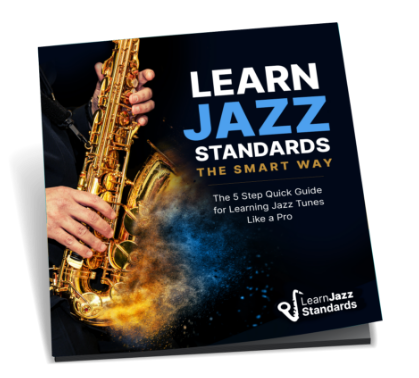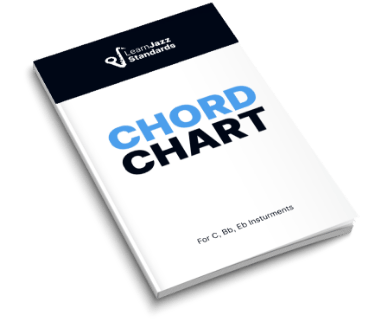Arpeggios are an important tool musicians use to outline changes and hit specific chord tones. Learning how to play arpeggios and applying them in creative ways over chord progressions is a feat many jazz musicians strive to accomplish.
If you struggle to understand arpeggios and how arpeggiation works, you’re in luck! We will go over arpeggios and how to use them to improve your improvisational skills.
We’ll cover—
- What arpeggios are
- 21 different types of arpeggios for chords you’ll encounter
- How to play and practice arpeggios for better solos
- Guitar and Piano resources to help you master these concepts
Want to play arpeggios effortlessly like a pro? Then you need to practice like a pro!
The Learn Jazz Standards Inner Circle helps musicians like you cut through all the noise and distraction so you can focus on seriously improving your musicianship and improvisational skills.
Want to get better in 30 days or less? Come see what the Inner Circle has to offer.
Table of Contents
What is an Arpeggio?
Simply put, an arpeggio is a chord played one note at a time. Sometimes called a broken chord, an arpeggio takes the notes in a chord and plays them as individual notes.
We get the word arpeggio from the Italian word arpeggiare.
If you place an “h” in front of that word, you get “harpeggiare.” This isn’t a coincidence, as the word arpeggiare means to play the harp. Harps are very suited to playing arpeggios, so it makes sense that the word is named after them. When we arpeggiate, we play like a harp.
You can arpeggiate any chord—major chords, minor chords, seventh chords, and so on. Arpeggios can also be played in ascending, descending, or mixed order. If it is a cluster of notes played one note at a time, it is an arpeggio!
Chord Recap
Before diving further into arpeggiated chords, let’s review chord fundamentals quickly to ensure you are up to speed. A refresher never hurts!
A chord is a cluster of notes played simultaneously. These notes are usually not random but derived from the intervallic relationships in the major scale. Western music typically uses tertiary harmony or chords constructed from stacked thirds.
Using the notes in the major scale, we can construct all seven diatonic chords:

To create a basic triad, let’s start with a C and follow the scale degrees of the C major scale to find our other two notes:
- C-D-E-F-G-A-B-C
- 1-2-3-4-5-6-7-1
When we put these intervals together, we get a C major chord:
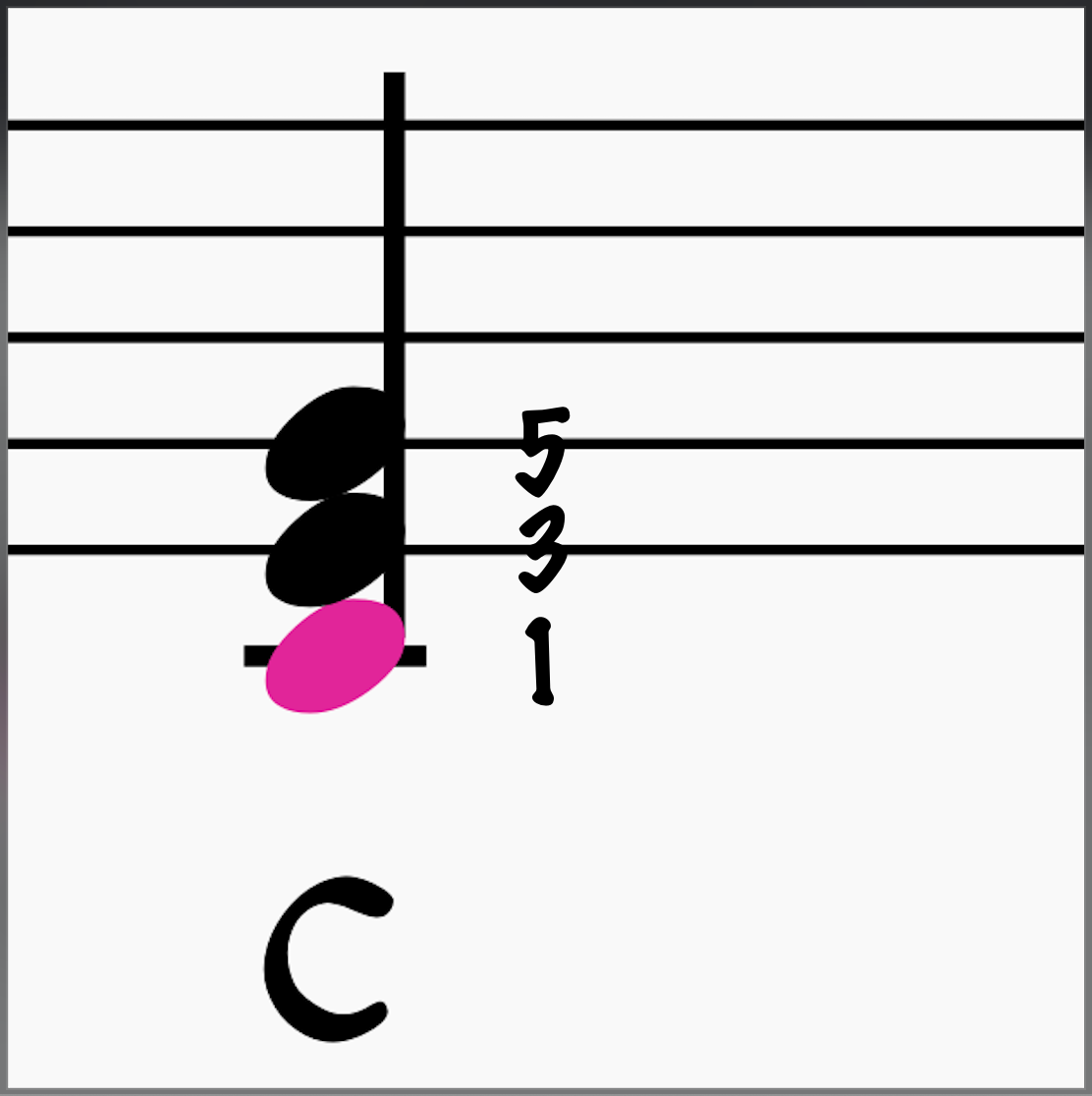
When we stack thirds from the other scale degrees in C, we get major triads, minor triads, and a diminished triad. Here are all diatonic triads built from the C major scale.
- I. C
- ii. D-
- iii. E-
- IV. F
- V. G
- vi. A-
- viiø. Bdim
Beyond Triads
In jazz and other genres of music, musicians often play chord qualities that are more complex than basic triads. You’ll usually see seventh chords, and sometimes, those chords have extensions and altered chord tones.
Seventh chords consist of four notes: a basic triad (root, 3rd, 5th) plus a 7th.
Take a C major triad and add a B (the seventh), and you’ll make a Cmaj7 chord.
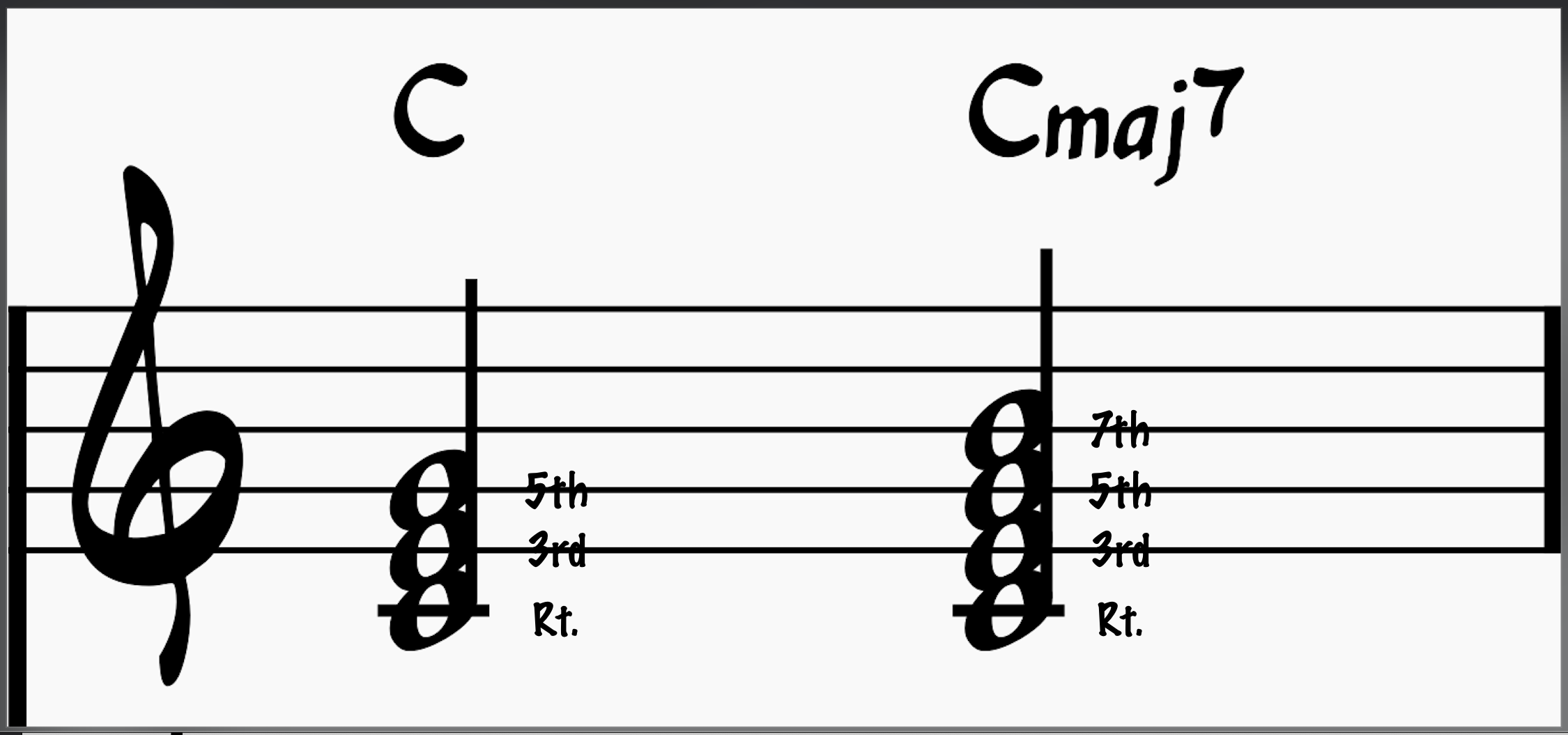
Seventh chords have many more varieties than triads, so most arpeggio exercises we’ll examine later will consist of seventh chord arpeggios.
For more on seventh chords, check out our guide to seventh chords.
Now that we’ve refreshed basic chord theory, let’s arpeggiate some chords!
Arpeggiated Chords
Arpeggios are found in all genres of music, from classical music to rock, jazz, pop, and blues. These musical devices are great tools for outlining harmony melodically (as individual notes). As a result, arpeggios are used in lead playing and melodies to outline the harmony in a chord progression.
To play an arpeggio, take a single chord and isolate the notes that comprise it.
Let’s use a major chord for our first example.
Major triads consist of three notes:
- the root note (rt)
- a major third (M3)
- a perfect fifth (P5)
Here is a C major chord arpeggio, played first as a chord and then in ascending and descending order:
- 5th: G
- 3rd: E
- Rt: C
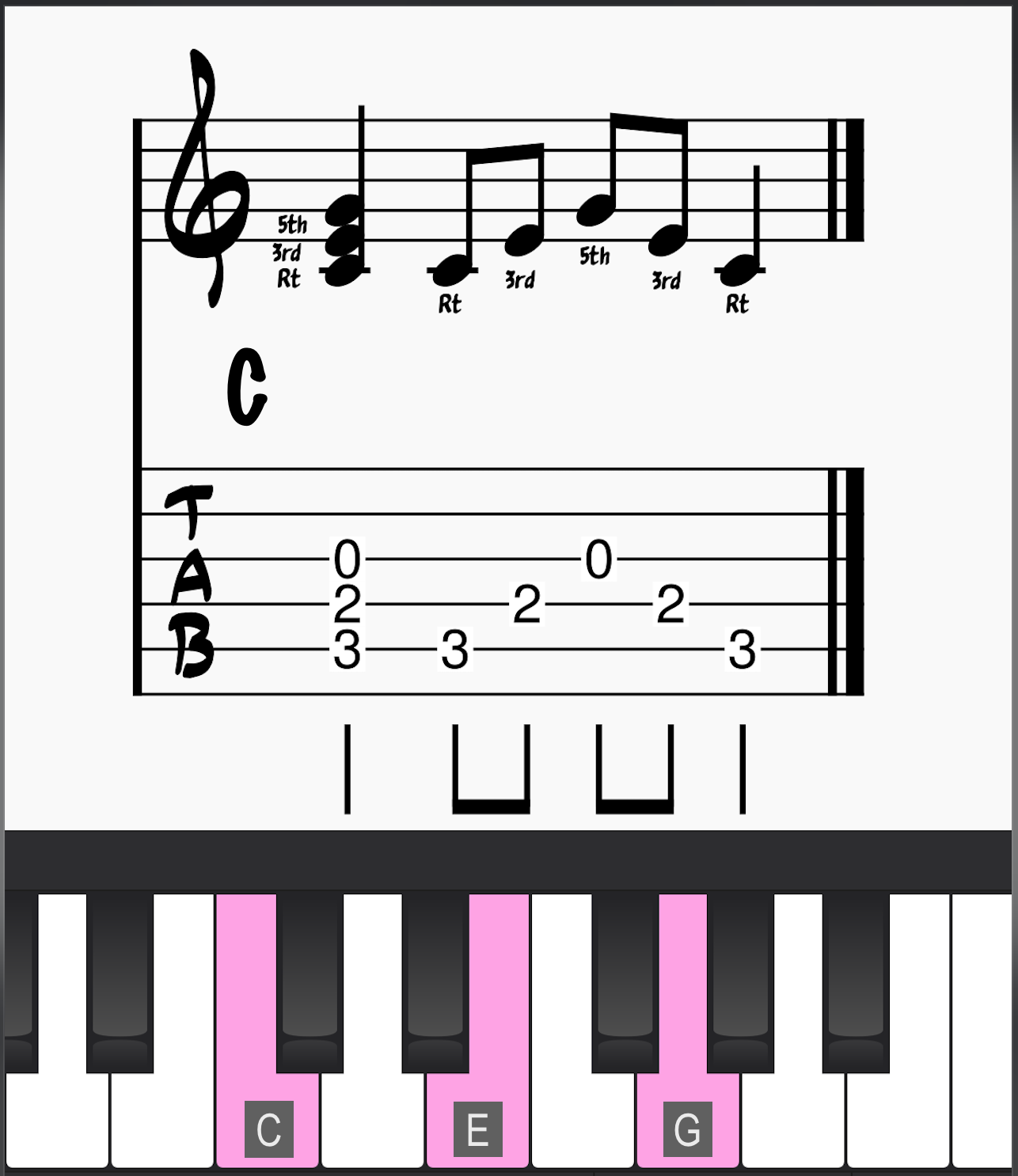
The more pieces of harmonic information you add to a chord, the more complex its arpeggio becomes. Seventh chords have four notes, so to arpeggiate a seventh chord, we need to add another note to our arpeggio.
- 7th: B
- 5th: G
- 3rd: E
- Rt: C
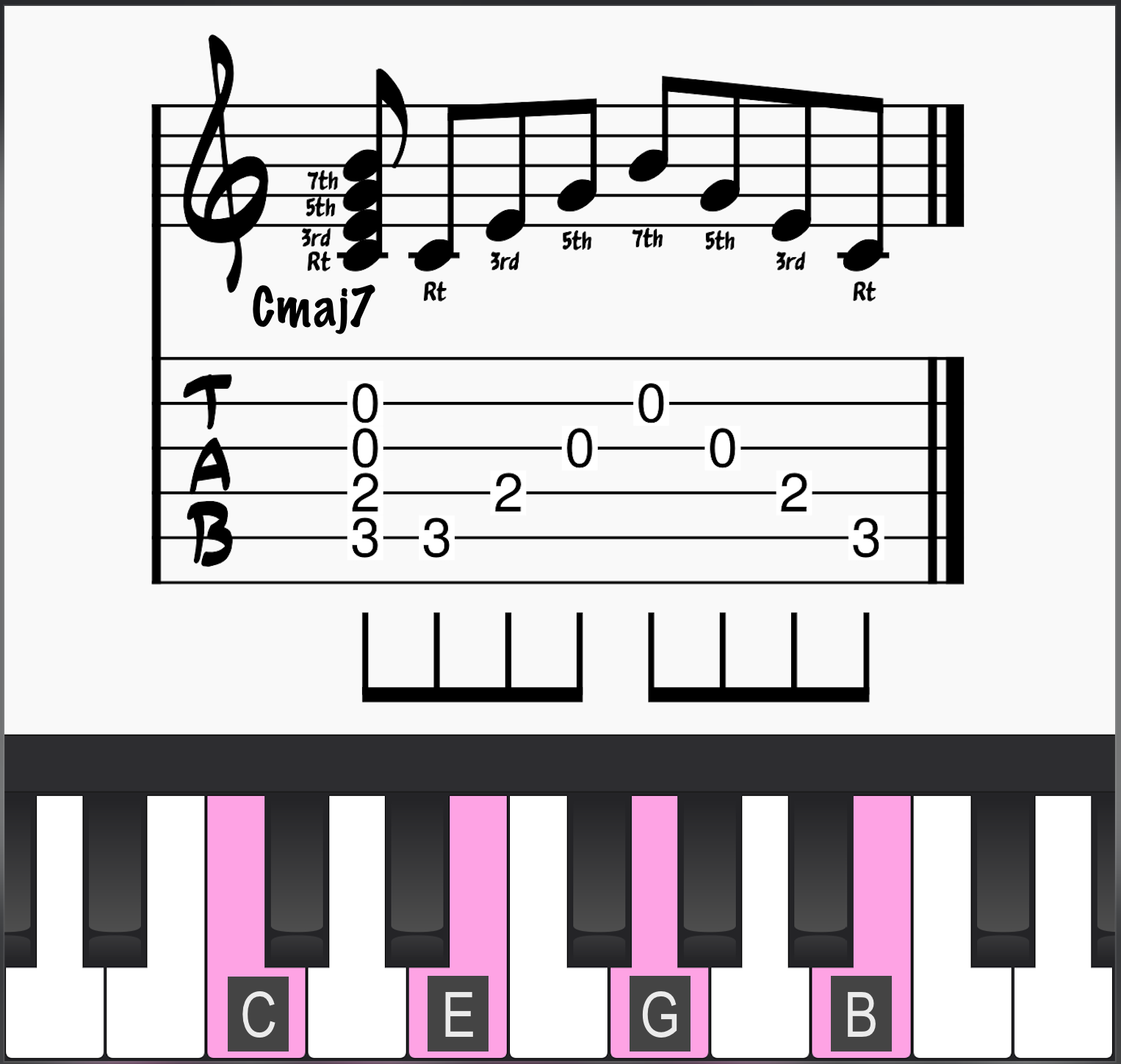
For more on triads, check out our guide to major triads. Though the examples given are on guitar, the theory is universal!
21 Arpeggios You Need To Know And How To Play Them On Guitar And Piano (or Any Instrument)
I hope you are ready!
This section will cover 21 essential arpeggios that will help your solos sound better! The following examples (except for the last) are all types of C chords you’ll definitely encounter when improvising over many different chord progressions.
Though we are using piano and guitar resources for our examples, this information is easily transferrable to other instruments (especially other instruments with strings like bass guitar!)
Arpeggiated Triads
We’ve got to start with triads, as they are the basic chord type from which all the other fancier chords are constructed. The following triad arpeggios will be in root position and span two octaves.
We’ll start on C and play up the first octave—Rt, 3rd, 5th. Then, we will play up the second octave, capping the arpeggio off with another root note (C).
1. Major Arpeggios
Major arpeggios have a root note, a major third, and a perfect fifth. Major triads are two consecutive intervals—a major third followed directly by a minor third: [C to E] and [E to G]. They can be played over major chords (I, IV, or V chord in major keys).
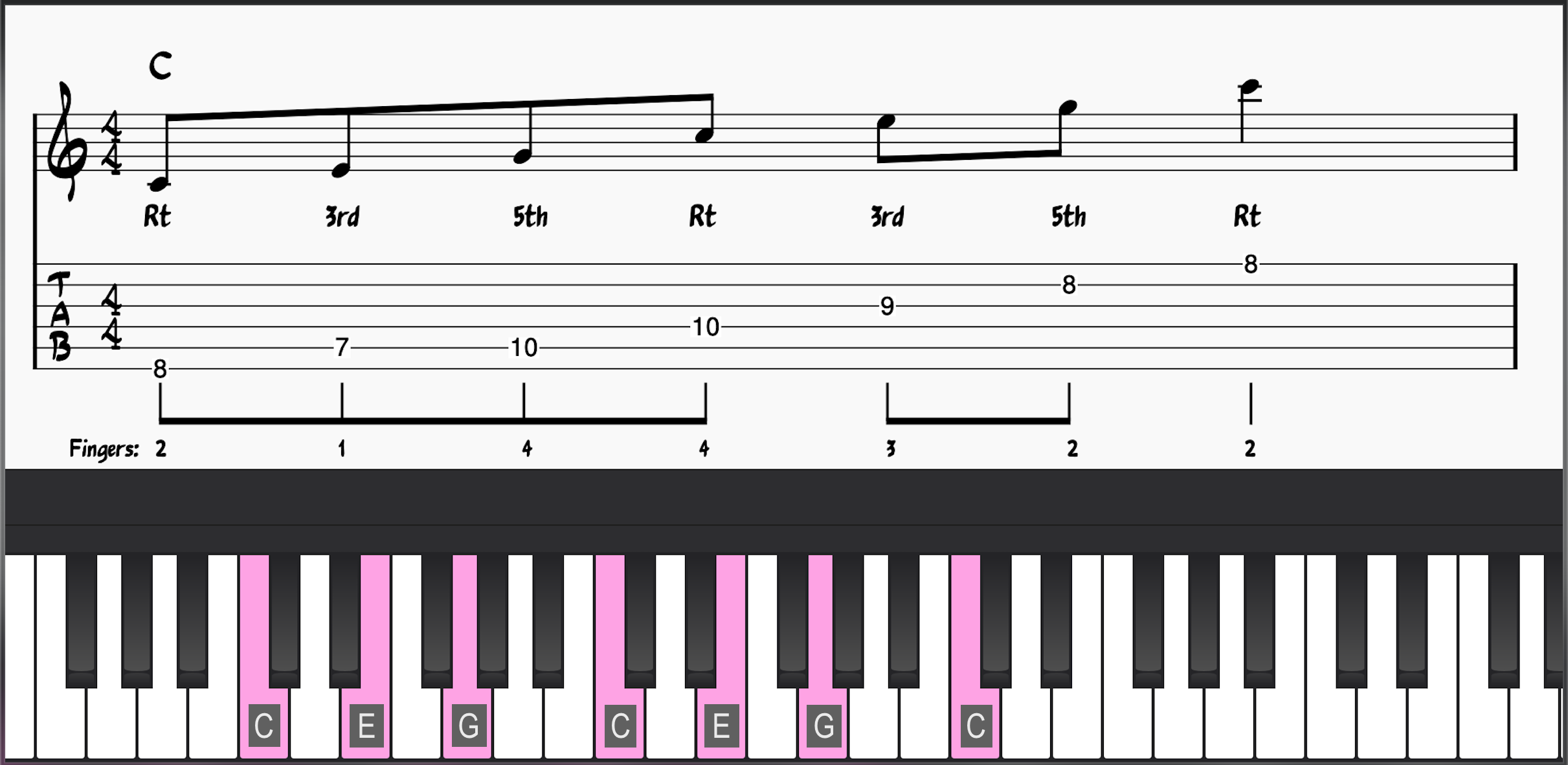
- 5th: G
- 3rd: E
- Rt: C
2. Minor Arpeggios
Minor arpeggios have a root note, a minor third, and a perfect fifth. You can think of them as a minor third interval followed directly by a major third interval: [C to Eb] and [Eb to G]. They can be played over minor chords (ii, iii, or vi in major keys).
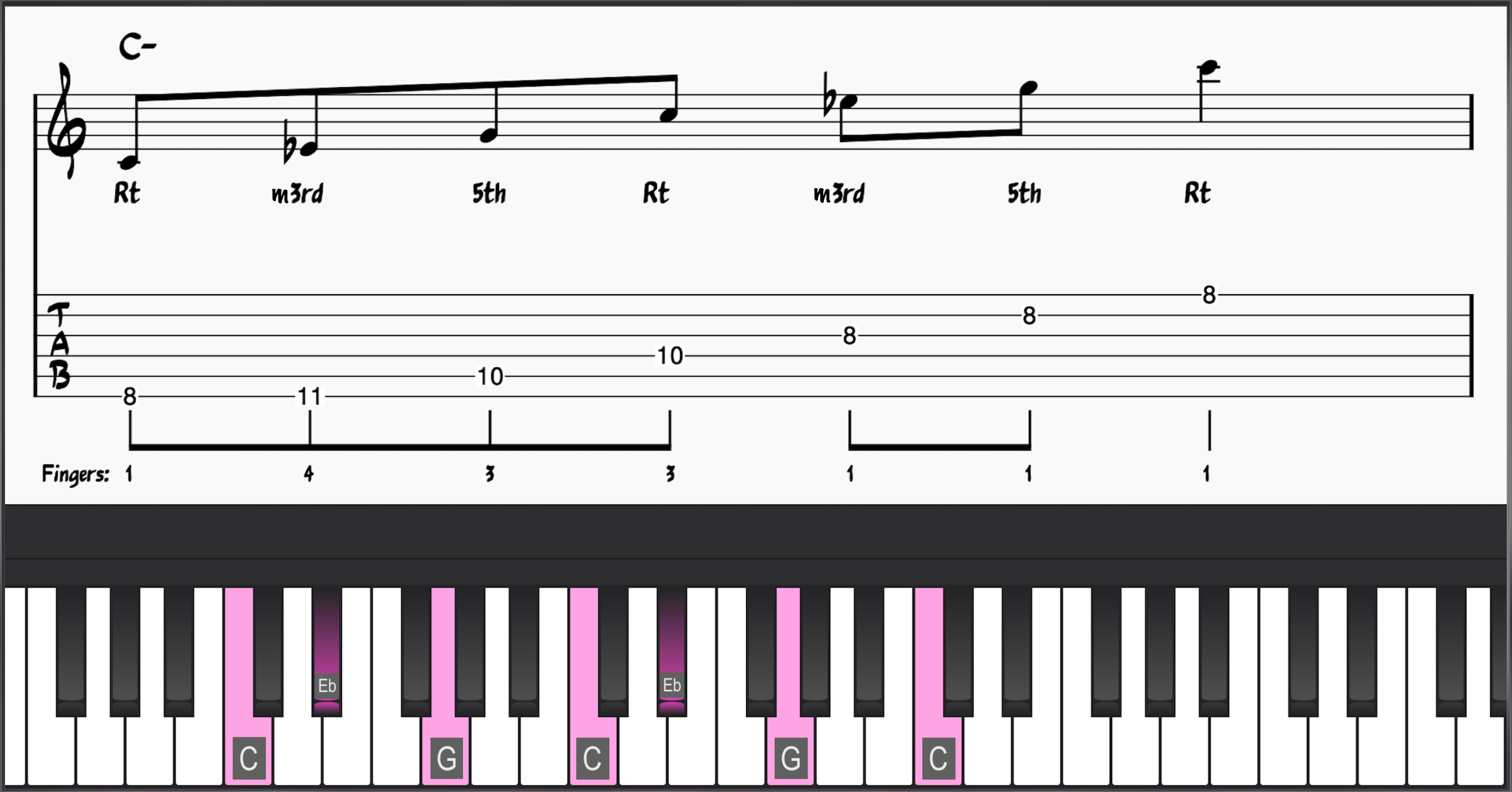
- 5th: G
- m3rd: Eb
- Rt: C
3. Diminished Arpeggios
Diminished arpeggios have a root note, a minor third, and a diminished fifth. They can also be thought of as two consecutive minor third intervals: [C to Eb] and [Eb to Gb]. Diminished arpeggios can be played over the vii° (major keys) or ii° chord (minor keys).
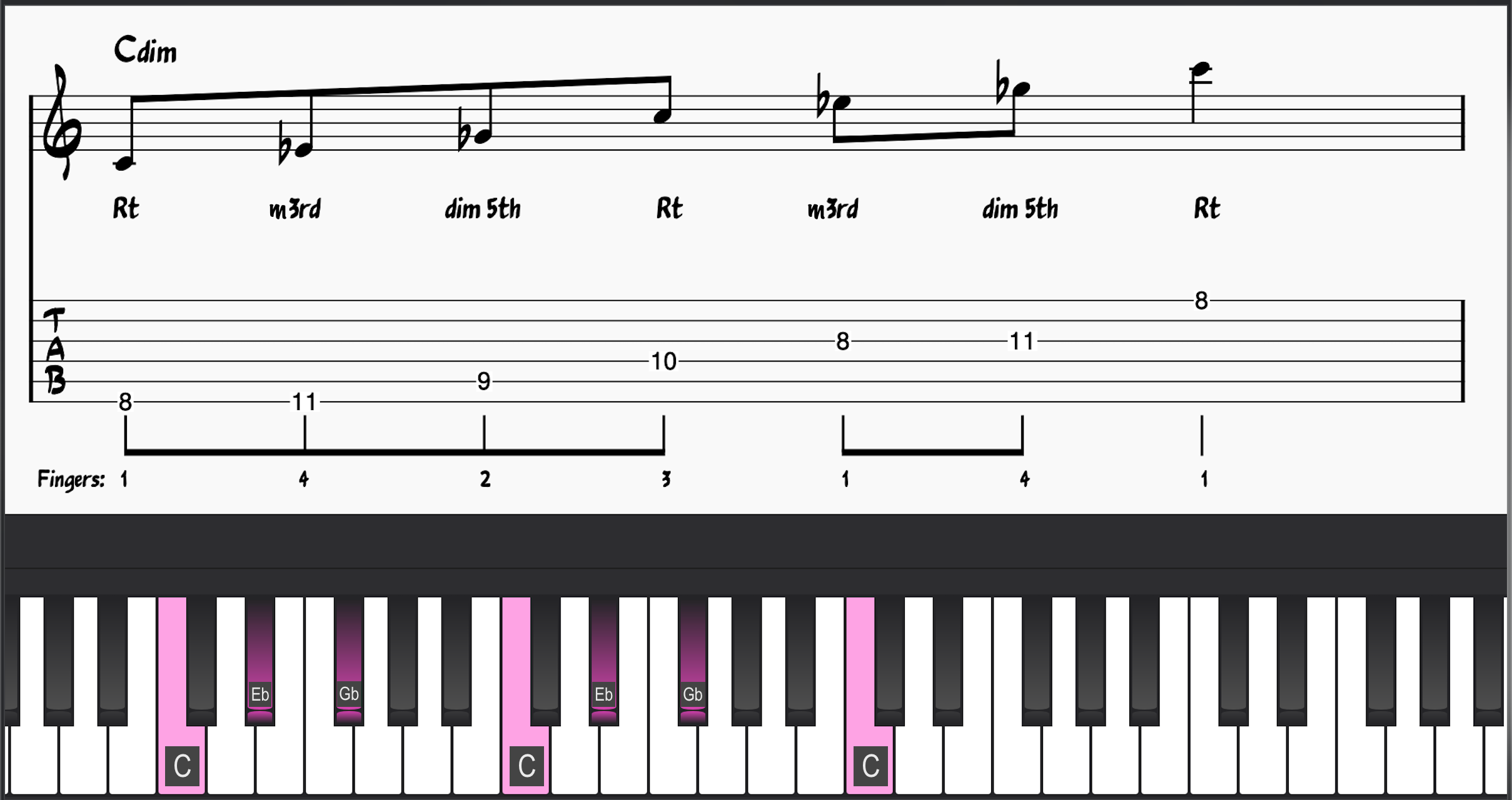
- dim 5th: Gb
- m3rd: Eb
- Rt: C
4. Augmented Arpeggios
Augmented arpeggios have a root note, a major third, and an augmented fifth. You can think of augmented triads like two consecutive major third intervals: [C to E] and [E to G#]. Augmented arpeggios are non-diatonic, meaning you won’t find them in major or natural minor keys.
However, they do appear in melodic and harmonic minor tonalities.
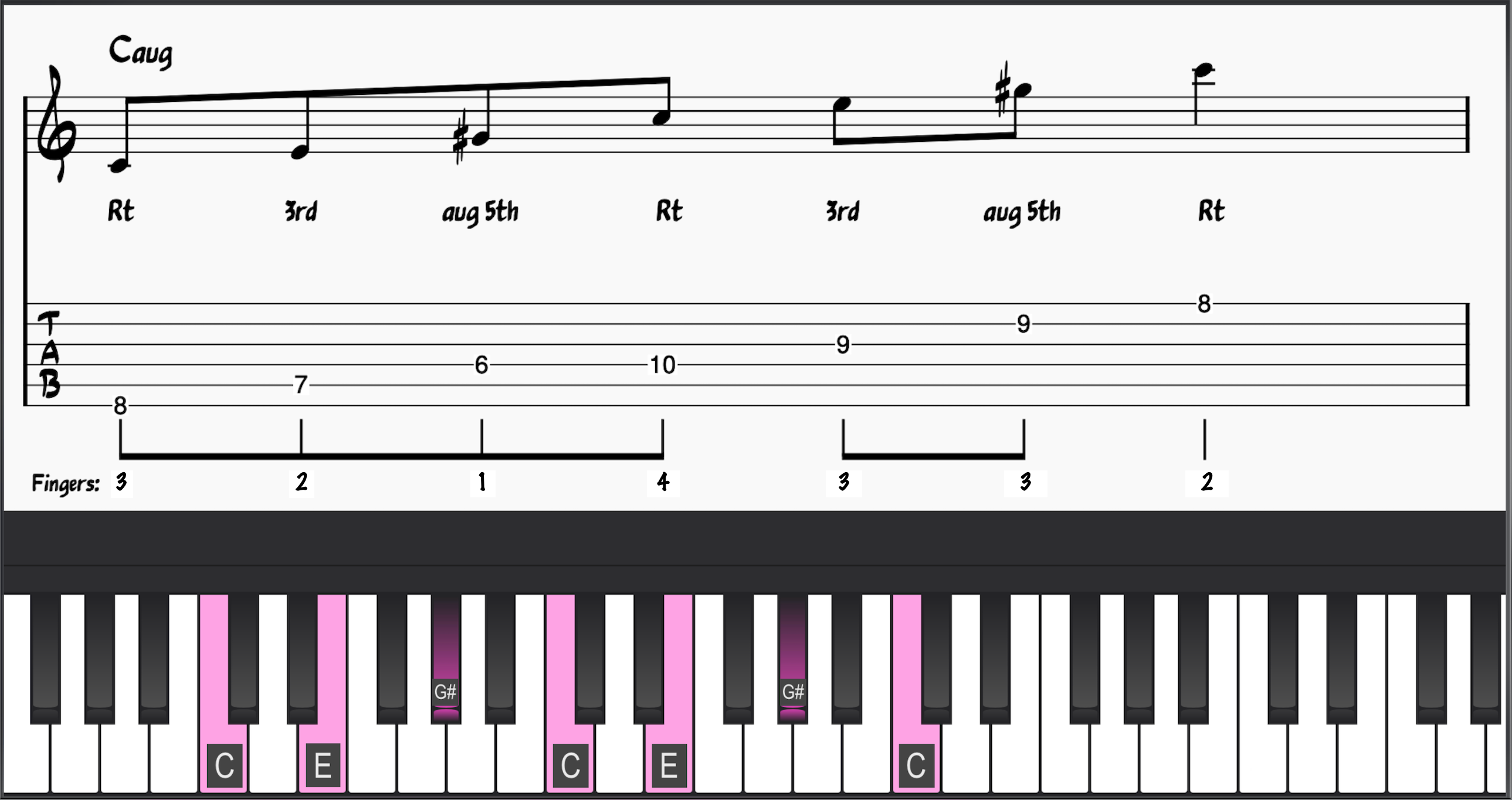
- Aug 5th: G#
- 3rd: E
- Rt: C
BEFORE YOU CONTINUE...
If you struggle to play amazing jazz solos and want to learn the secret strategies the pros are using to improvise, our free guide will get you on the right track.

Arpeggiated Seventh Chords
Now, let’s explore arpeggiated seventh chords! First, we’ll look at the basic seventh chords and then explore common chord extensions and alterations you’ll likely encounter.
5. Major Seventh Arpeggios
Major seventh arpeggios have a root note, a major third, a perfect fifth, and a major seventh. You can think of them like a major triad [C, E, and G] plus a major 7th interval [B]. They are usually used for the I or the IV chord in chord progressions.
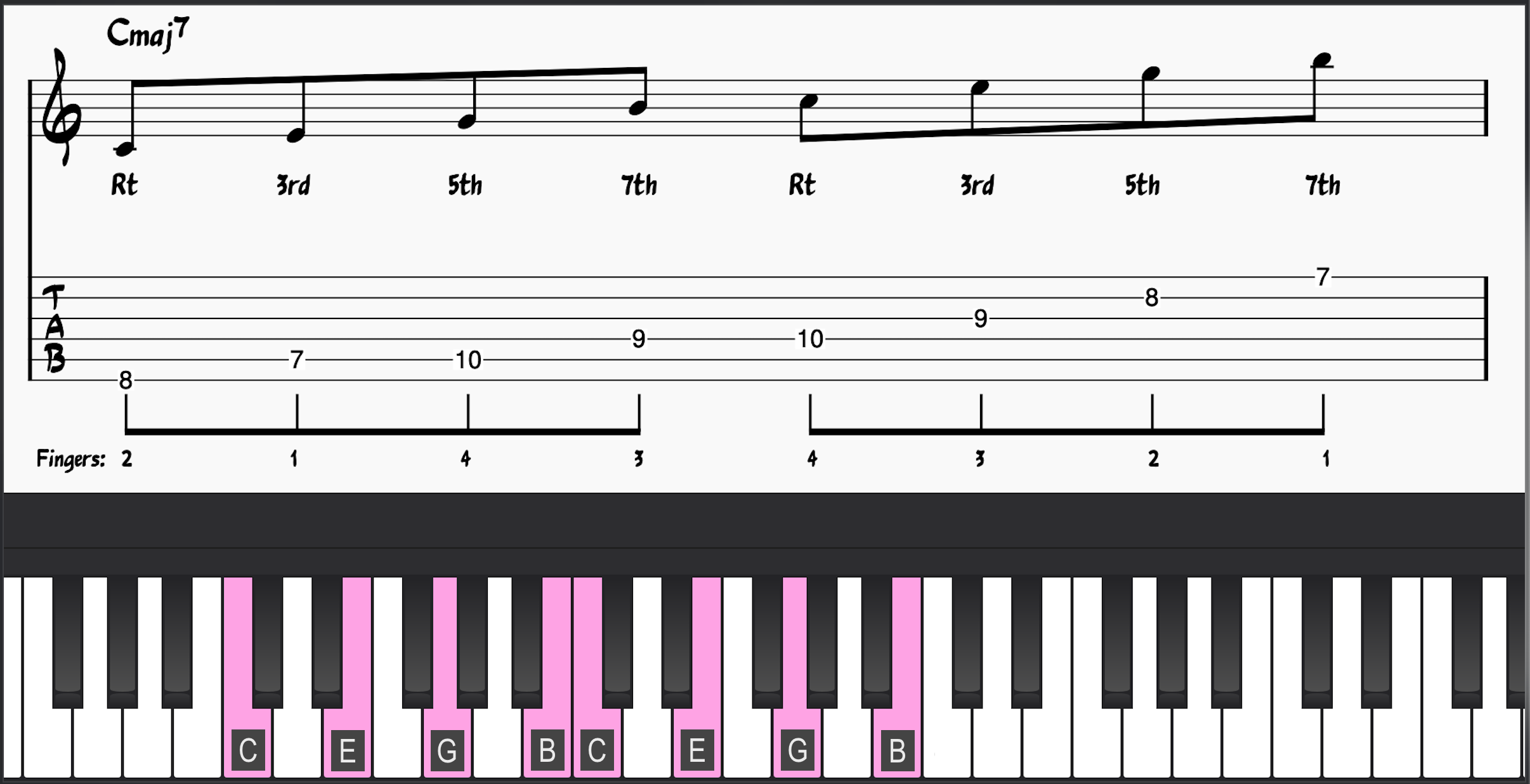
- 7th: B
- 5th: G
- 3rd: E
- Rt: C
6. Minor Seventh Arpeggios
Minor seventh arpeggios have a root note, a minor third, a perfect fifth, and a minor seventh interval. They are minor triads [C, Eb, and G] plus a minor seventh [Bb]. They usually represent minor chords (ii, iii, and vi chords).
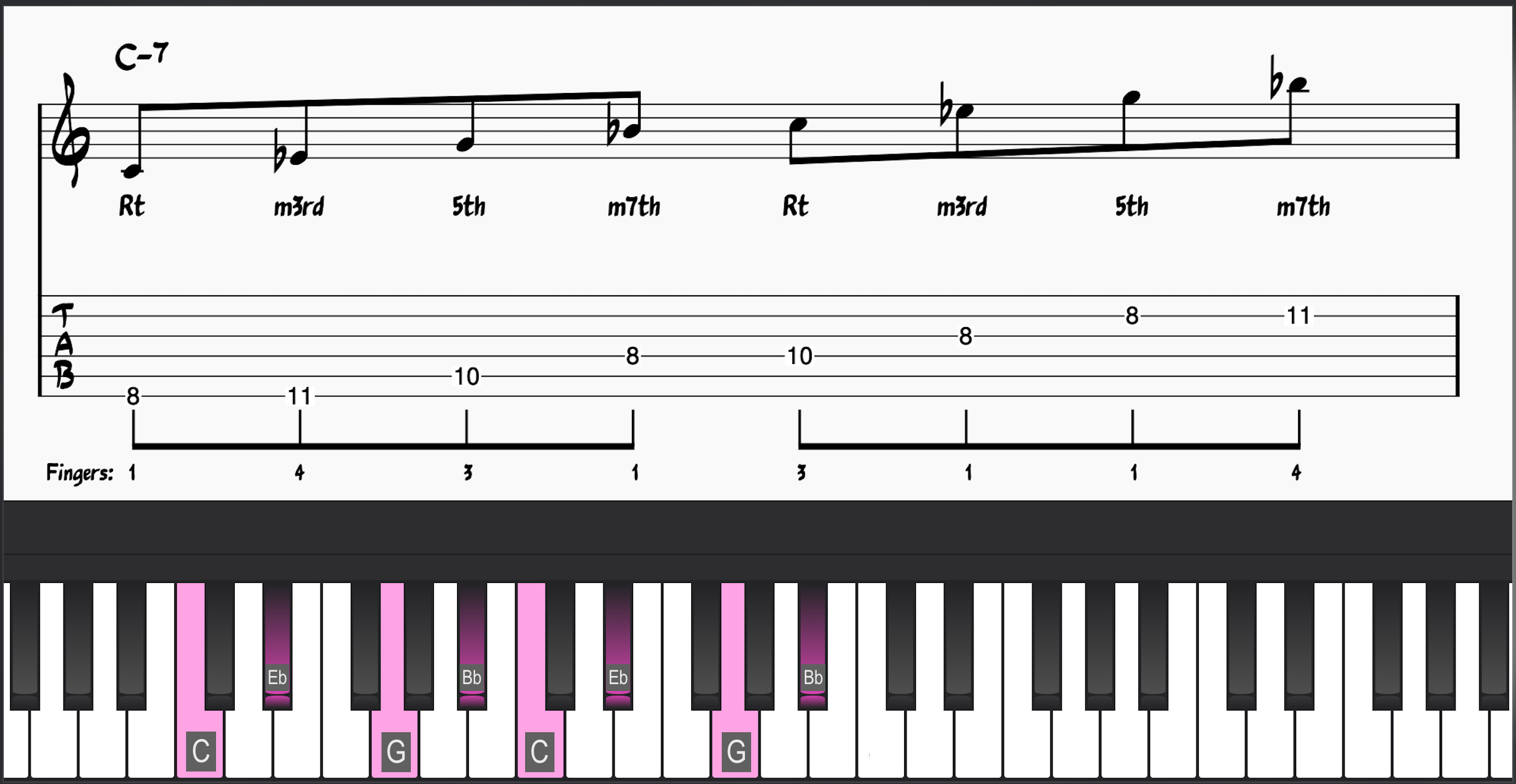
- m7th: Bb
- 5th: G
- m3rd: Eb
- Rt: C
7. Dominant Arpeggios
Dominant seven arpeggios have a root note, a major third, a perfect fifth, and a minor seventh interval. They are made of a major triad [C, E, and G] plus a minor seventh interval [Bb] and usually function as the V chord or a secondary dominant in chord progressions.
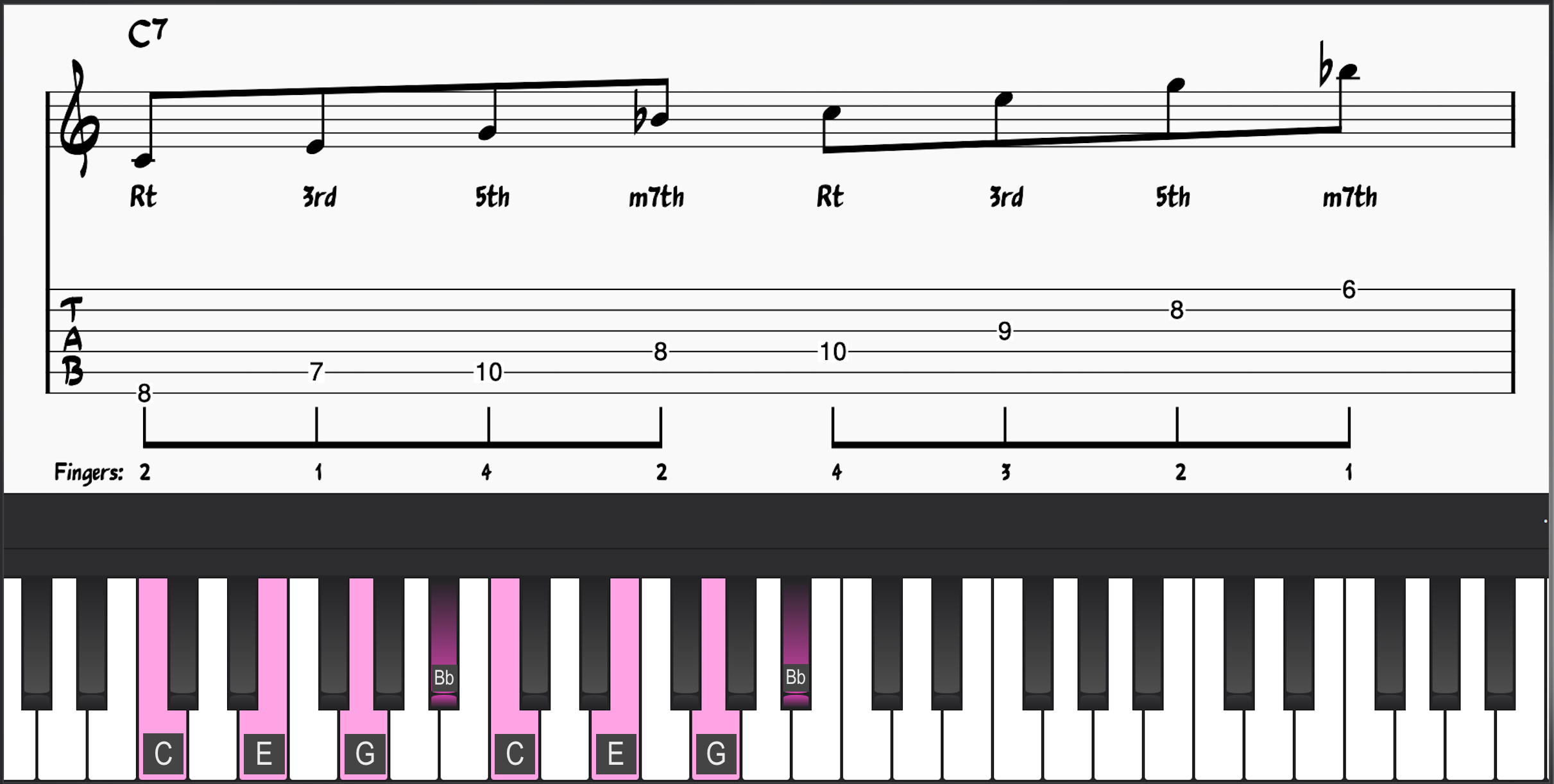
- m7th: Bb
- 5th: G
- 3rd: E
- Rt: C
8. Half-Diminished Arpeggios
Half-diminished chords have a root note, a minor third, a diminished fifth, and a minor seventh interval. They are diminished triads [C, Eb, Gb] with a minor seventh interval [Bb] added on. In diatonic keys, half-diminished arpeggios can be played over the vii° chord (major keys) or the ii chord (minor keys).
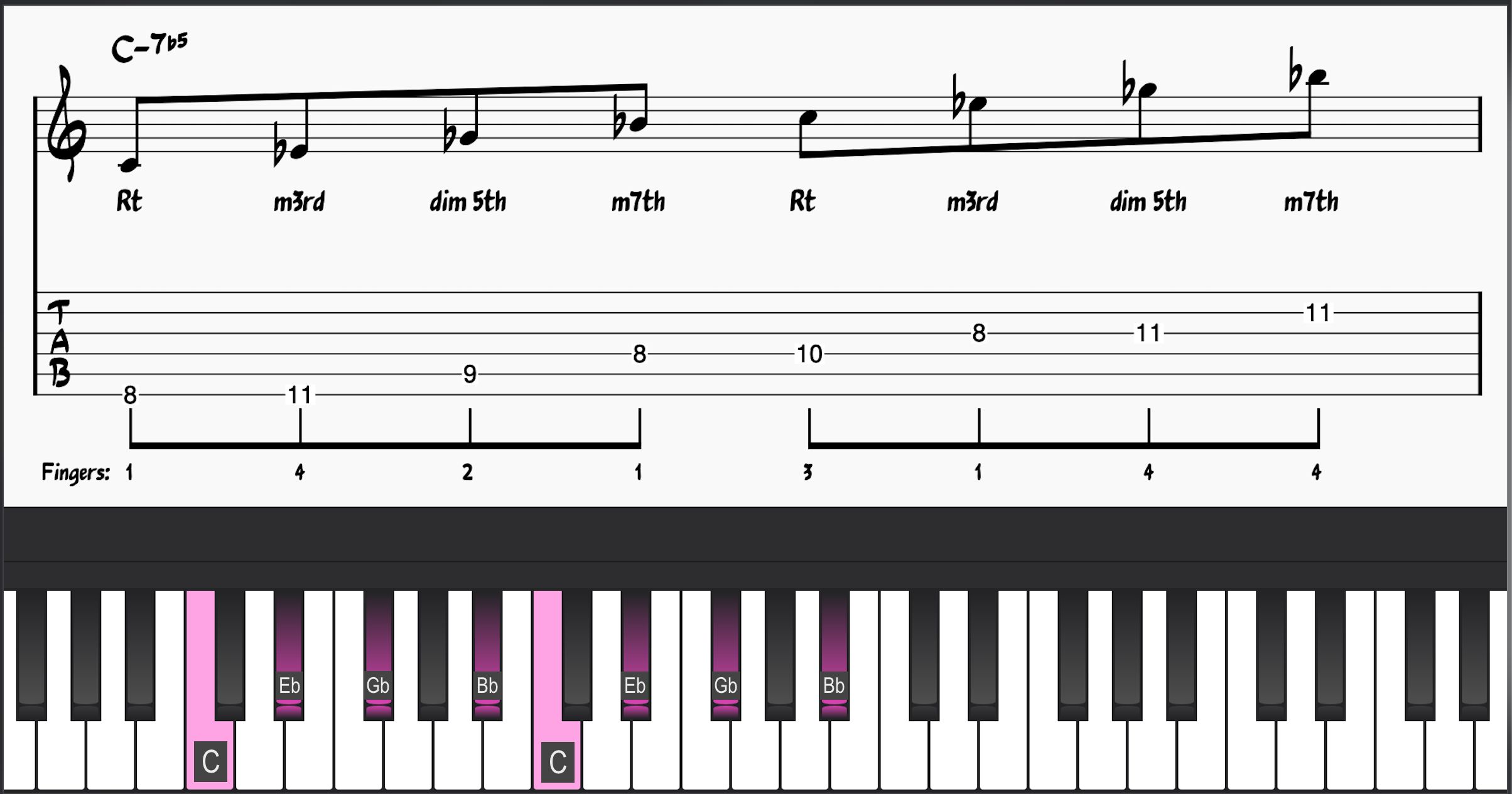
- m7th: Bb
- dim 5th: Gb
- m3rd: Eb
- Rt: C
9. Fully Diminished Arpeggios
Fully diminished arpeggios are non-diatonic and consist of a root note, a minor third, a diminished fifth, and a diminished seventh (a flattened minor 7th interval; enharmonically equivalent to a major 6th). Though not present in major or natural minor keys, this chord can be found in harmonic minor.

- dim 7th: Bbb (A)
- dim 5th: Gb
- m3rd: Eb
- Rt: C
Arpeggios With Chord Extensions and Alterations
Let’s dig into the really cool sounds by exploring extensions and alterations. Before we start, it’s important to mention that as we add more notes into the mix, the patterns might change to help everything fit together better across measures.
You’ll notice that some of the following arpeggio exercises may have a quick pivot in the middle to re-establish the root or to outline a specific sound. Additionally, it’s common to include lower extensions in chords with higher extensions.
For example, you’ll often see the 9th included in #11 or major 13 chords. Or a b9 or #9 included in b13 chords. You’ll see examples of this below.
10. Maj(9) Arpeggios
Maj9 chords add the compound interval of a 9th over a major seventh chord: [C, E, G, B] plus [D].
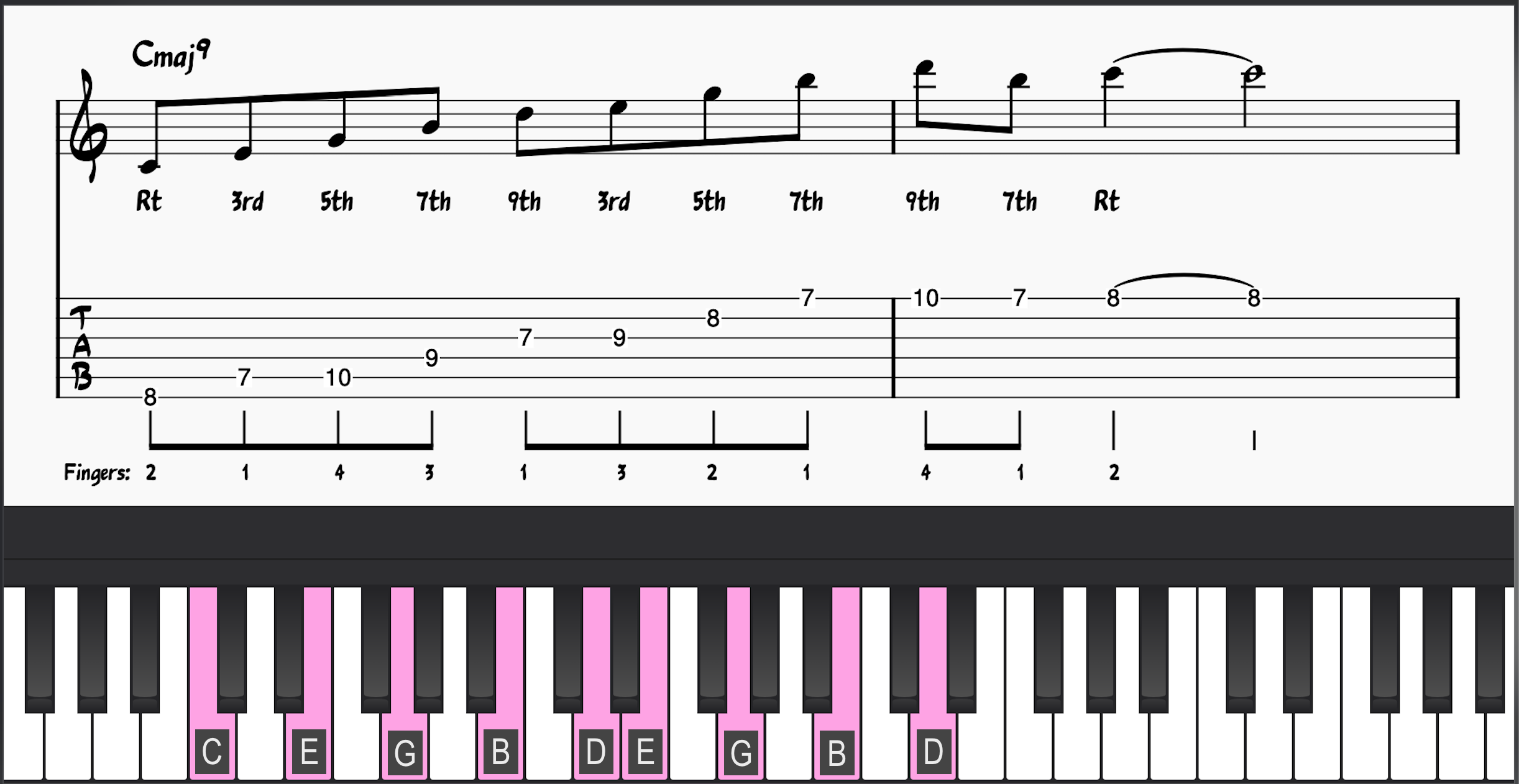
- 9th: D
- 7th B
- 5th: G
- 3rd: E
- Rt: C
11. Maj(#11) Arpeggios
Maj7#11 arpeggios add a #11 over a major seventh chord: [C, E, G, B] plus [F#]. These arpeggios can also include the 9th.
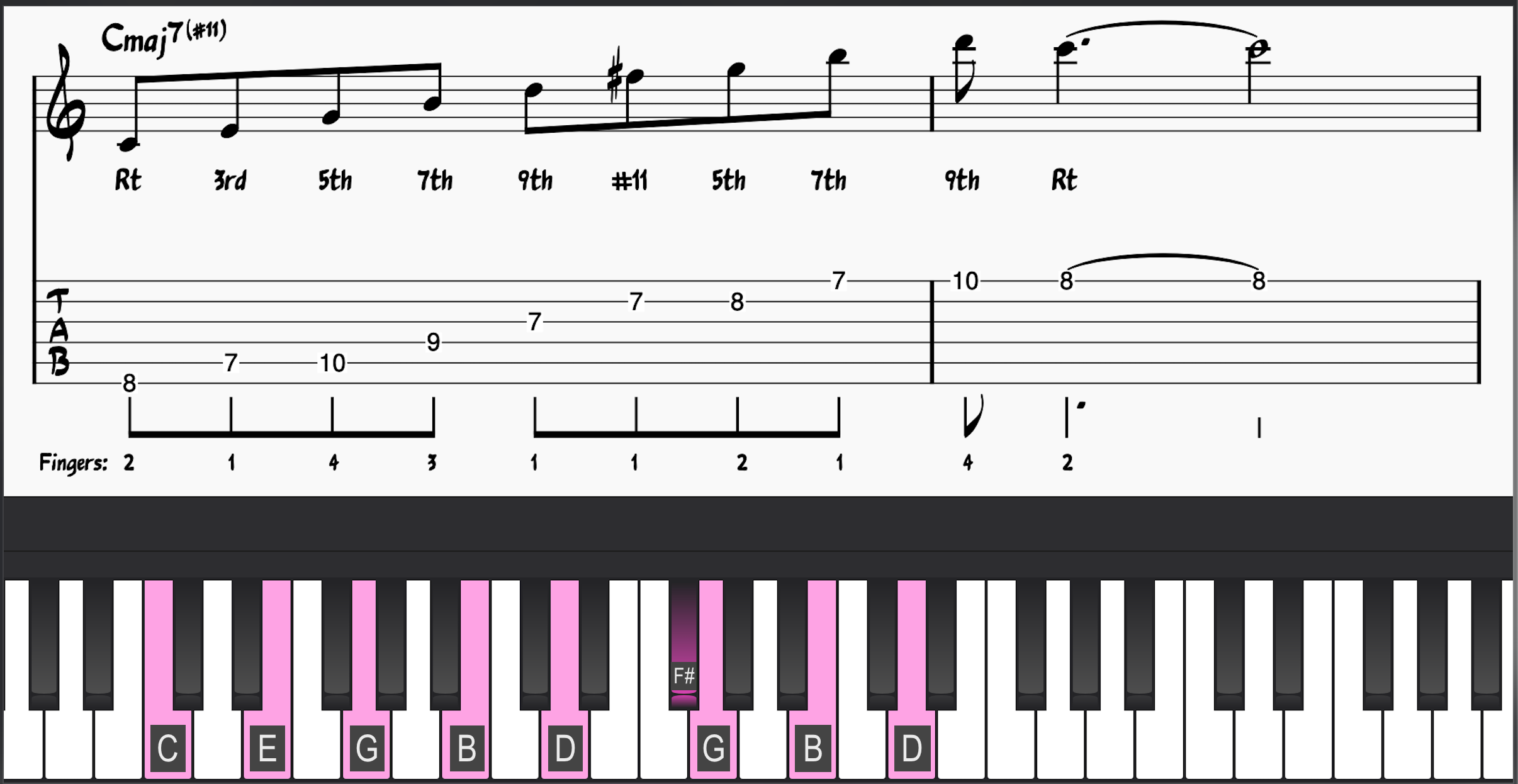
- #11th: F#
- (9th: D)
- 7th B
- 5th: G
- 3rd: E
- Rt: C
12. Maj(13) Arpeggios
Major 13 arpeggios add a 13th compound interval to a major seventh chord: [C, E, G, B] plus [A]. Depending on the situation, these arpeggios can also include the 9th or #11th.
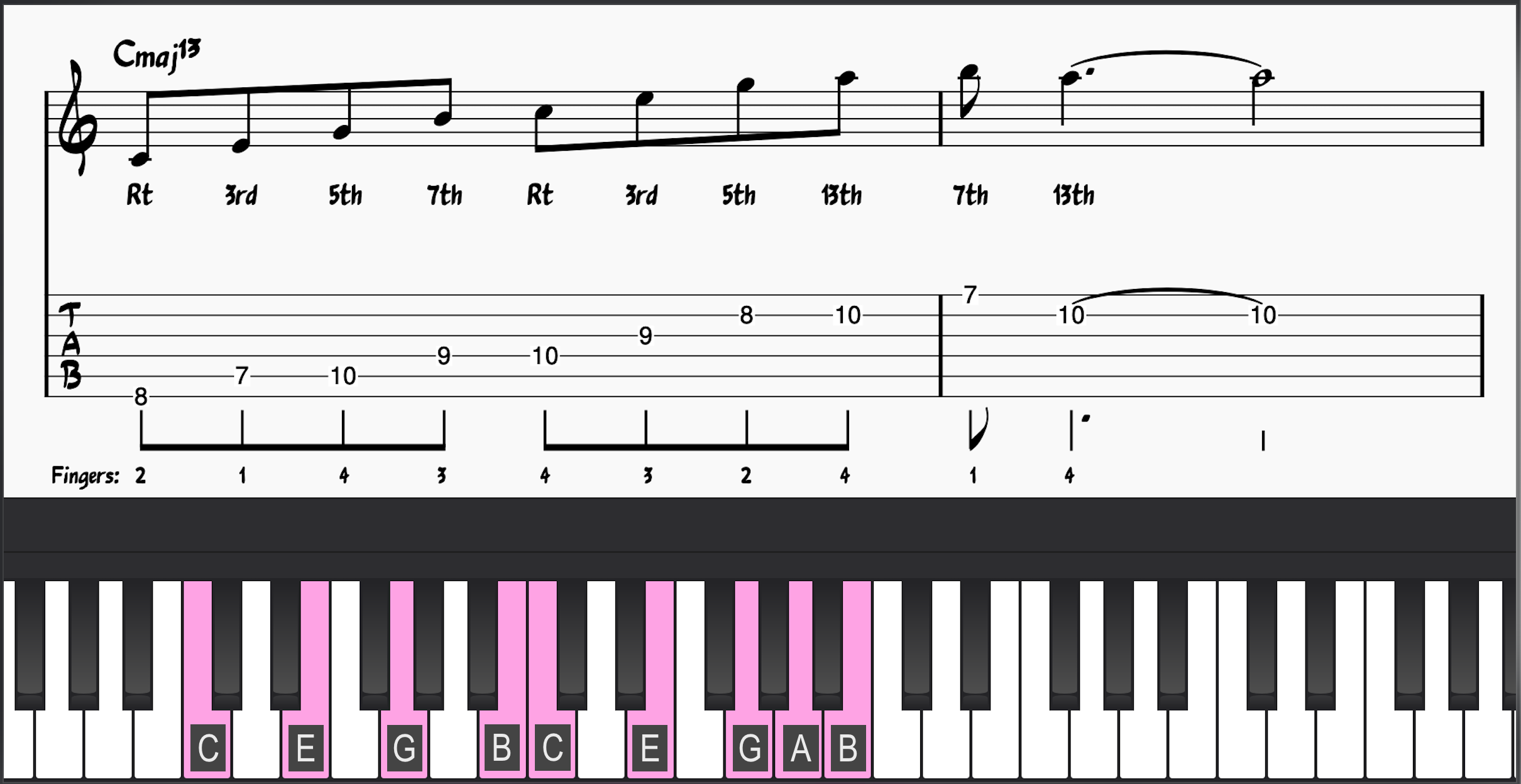
- 13th: A
- (#11th: F#)
- (9th: D)
- 7th B
- 5th: G
- 3rd: E
- Rt: C
13. Dominant 9 Arpeggios
Dominant 9 arpeggios take a dominant seventh chord and add a compound 9th interval on top: [C, E, G, Bb] plus [D].
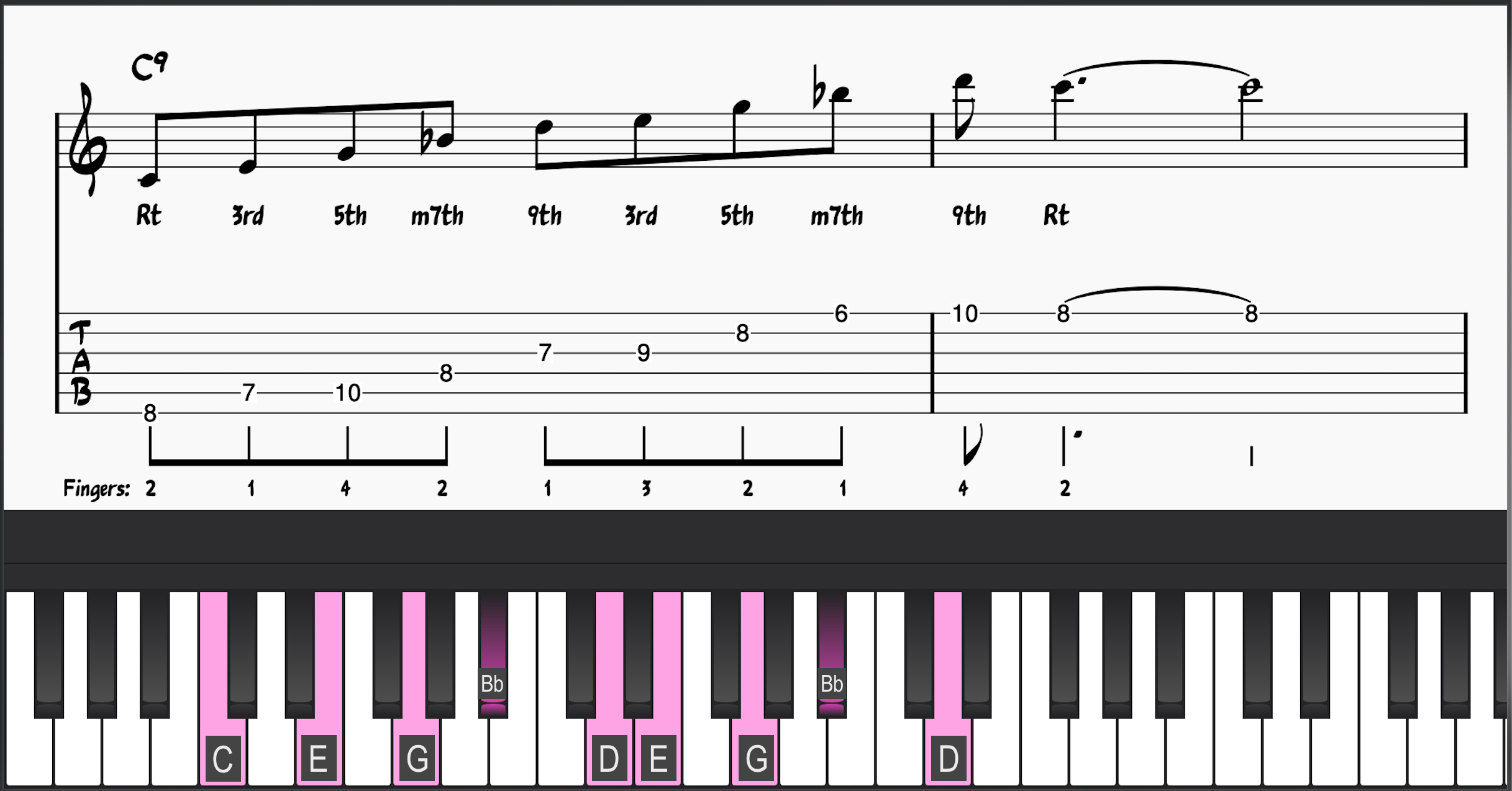
- 9th: D
- m7th Bb
- 5th: G
- 3rd: E
- Rt: C
14. Dominant b9 Arpeggios
Dominant flat 9 arpeggios are made from a seventh chord and a flat 9 compound interval: [C, E, G, Bb] plus [Db]. These arpeggios are great for playing over dominant chords in ii-V-I and minor iiø-V-i chord progressions.
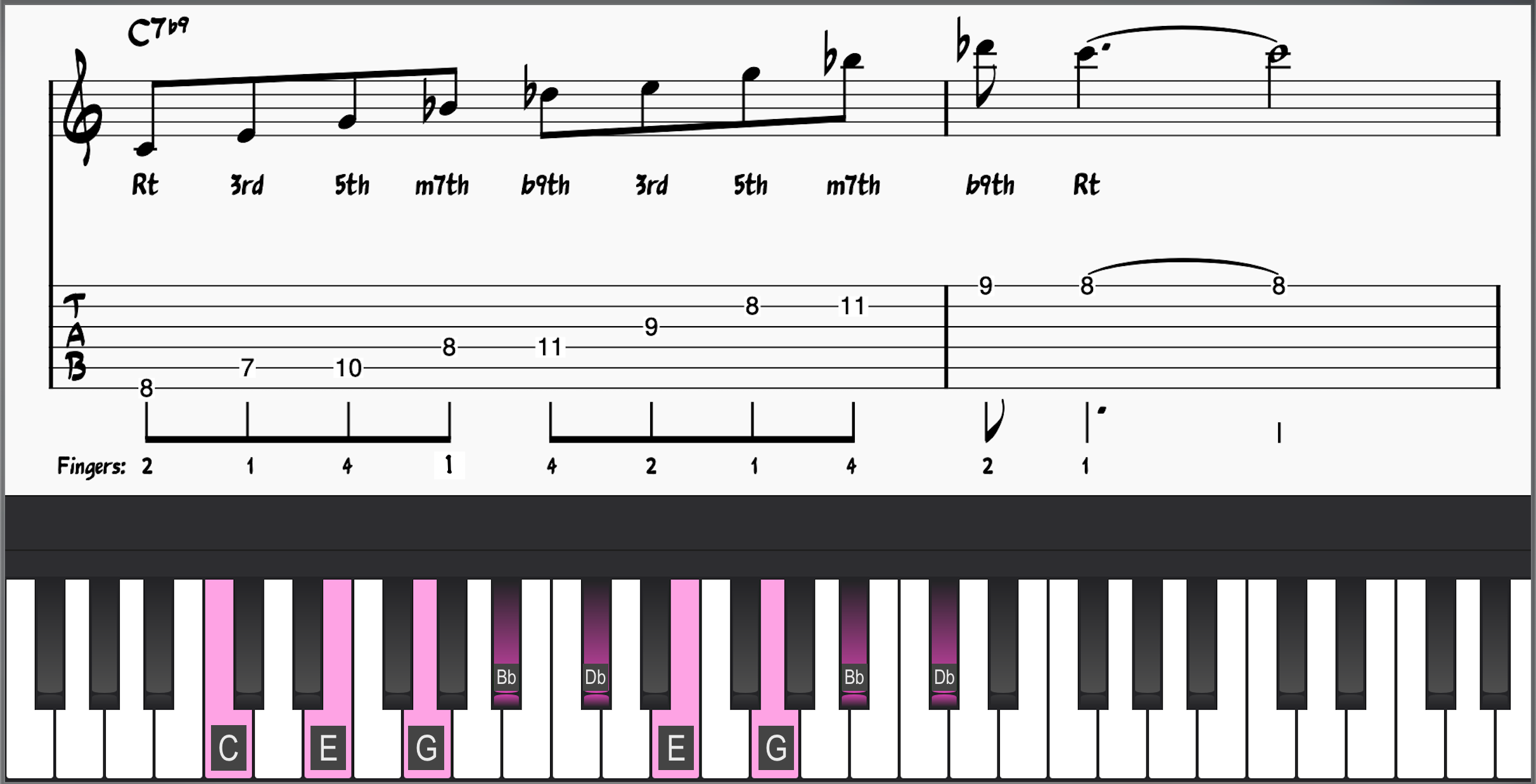
- b9th: Db
- m7th Bb
- 5th: G
- 3rd: E
- Rt: C
15. Dominant #9 Arpeggios
Dominant #9 arpeggios take a dominant seventh chord and add a #9 interval on top: [C, E, G, Bb] plus [D#], which is enharmonically equivalent to Eb or a minor 3rd. These arpeggios can also contain b9s, depending on the specified harmony (alt. chords, for example).
Like b9th arpeggios, these arpeggios are useful over altered dominant chords and add color to any standard ii-V-I chord progression.

- #9th: D#
- (b9th: Db)
- m7th Bb
- 5th: G
- 3rd: E
- Rt: C
16. Dominant #11 Arpeggios
Dominant #11 arpeggios add a #11th compound interval to a dominant seventh chord: [C, E, G, Bb] plus [F#]. Depending on the specified harmony, these arpeggios may include different types of 9ths (b9, natural 9, or #9). Our example includes natural 9ths:
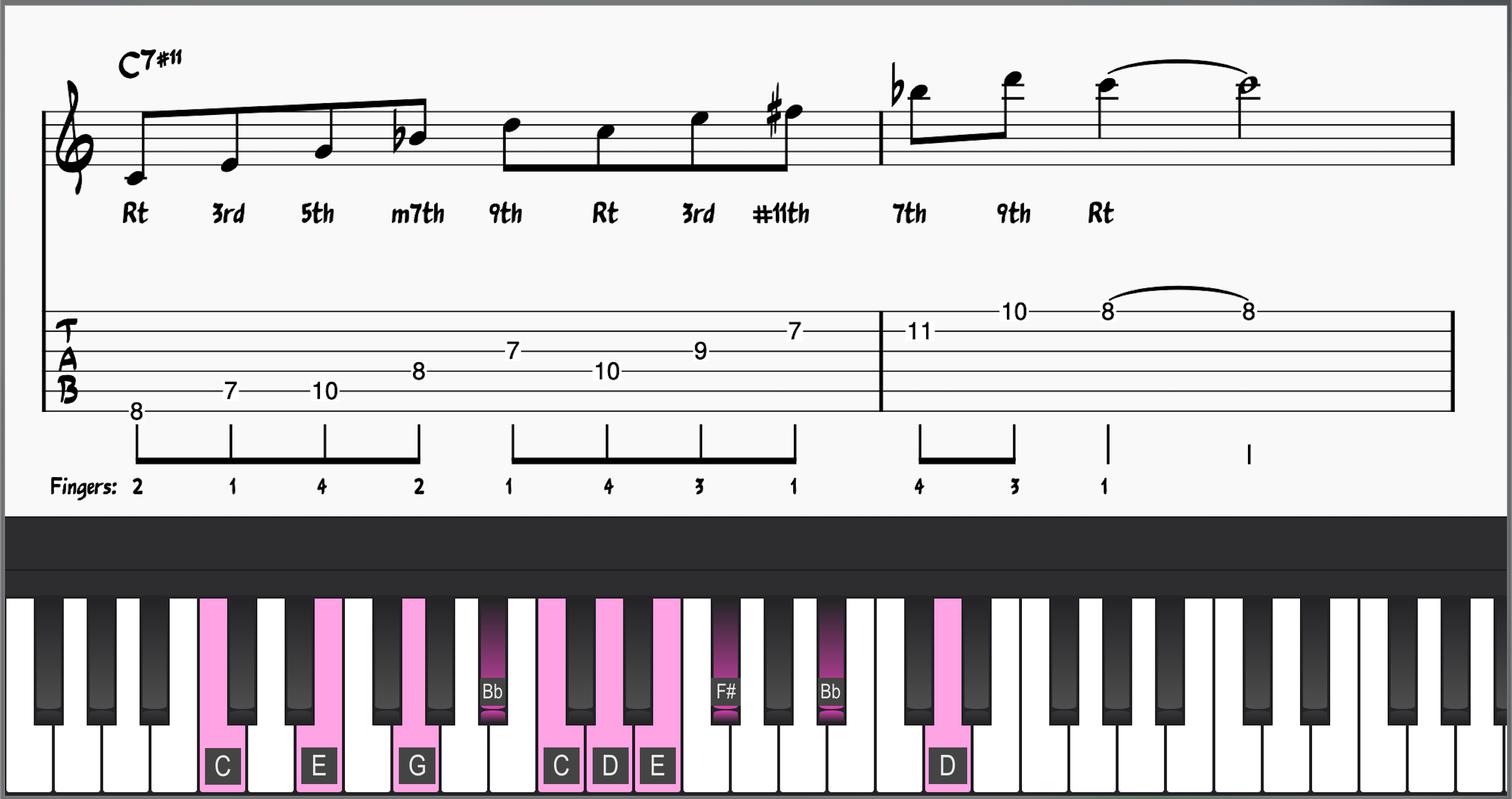
- #11th: F#
- (9th: D)
- m7th Bb
- 5th: G
- 3rd: E
- Rt: C
17. Dominant b13 Arpeggios
Dominant b13th arpeggios take a dominant seventh chord and add a b13th compound interval into the mix: [C, E, G, Bb] plus [Ab or G# depending on context]. These arpeggios can include other altered extensions, depending on the harmonic situation. Ours includes a b9th:
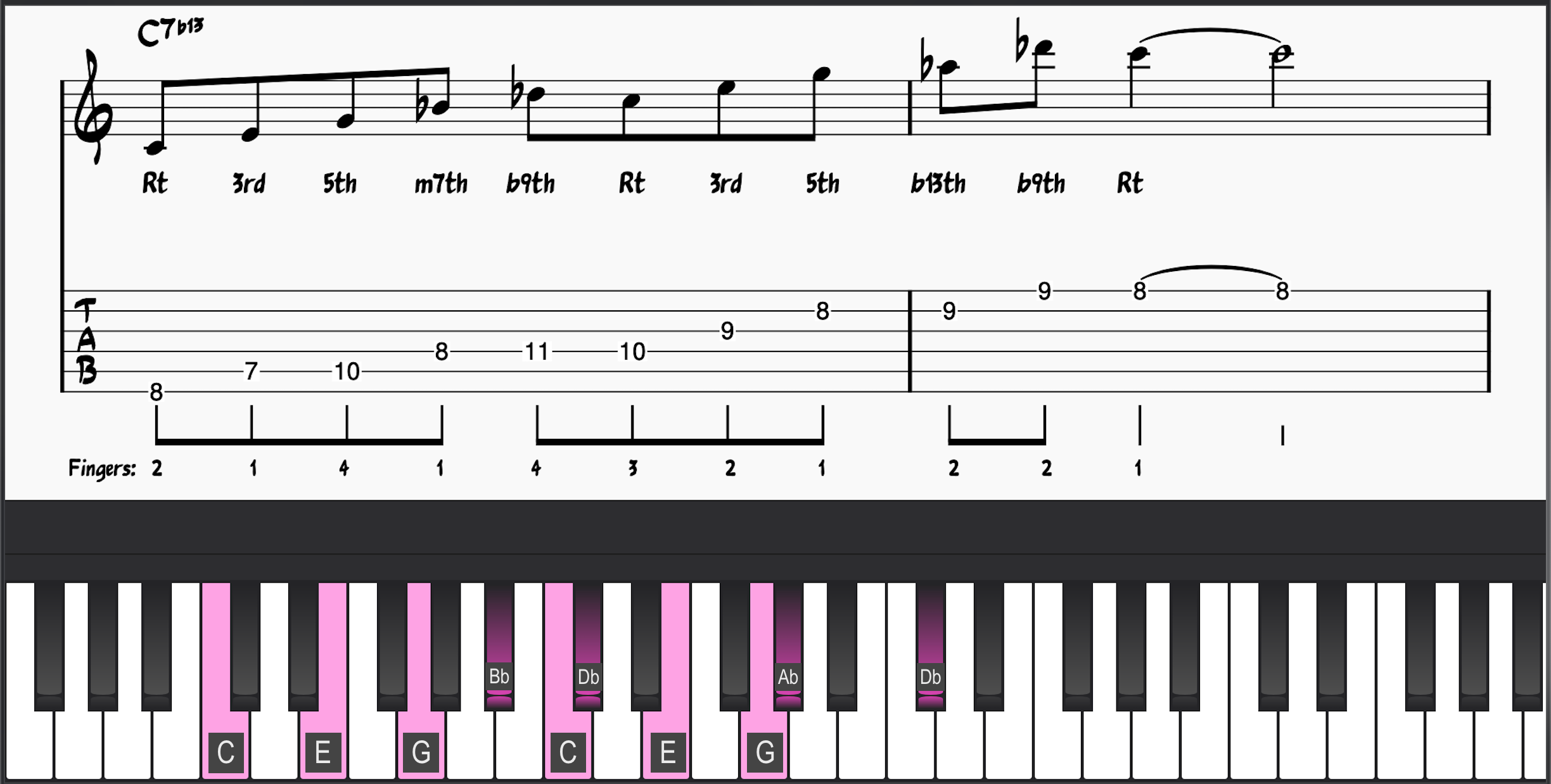
- b13th: Ab
- (b9th: Db)
- m7th Bb
- 5th: G
- 3rd: E
- Rt: C
18. Dominant 13 Arpeggios
Dominant 13th arpeggios take a dominant seventh chord and add a 13th compound interval into the mix: [C, E, G, Bb] plus [A]. These arpeggios can include other extensions, depending on the harmonic situation. Ours includes a 9th:
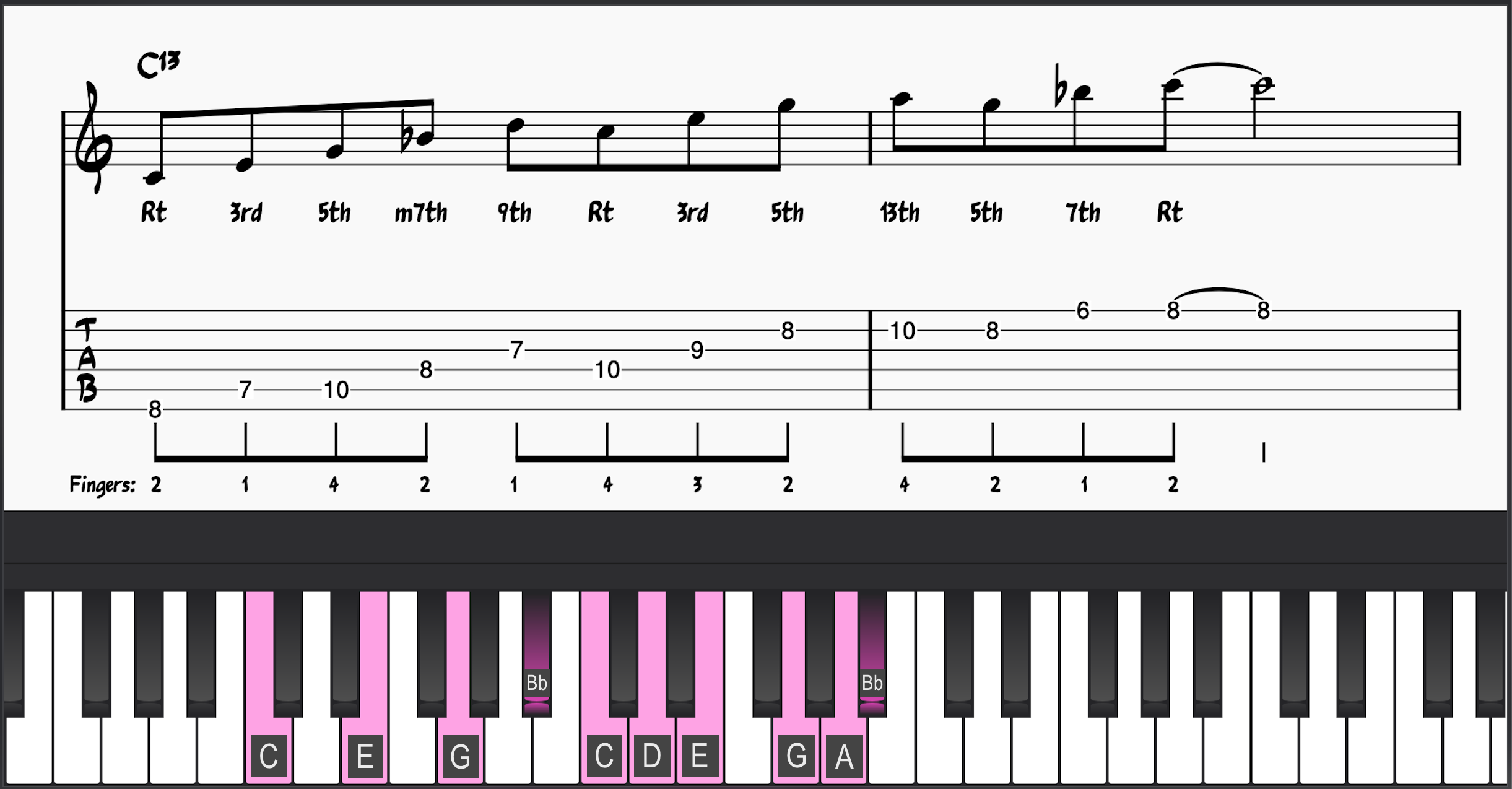
- 13th: A
- (9th: D)
- m7th Bb
- 5th: G
- 3rd: E
- Rt: C
19. Minor 9 Arpeggios
Minor 9th arpeggios take a minor seventh chord and add a compound 9th interval on top: [C, Eb, G, and Bb] plus [D].
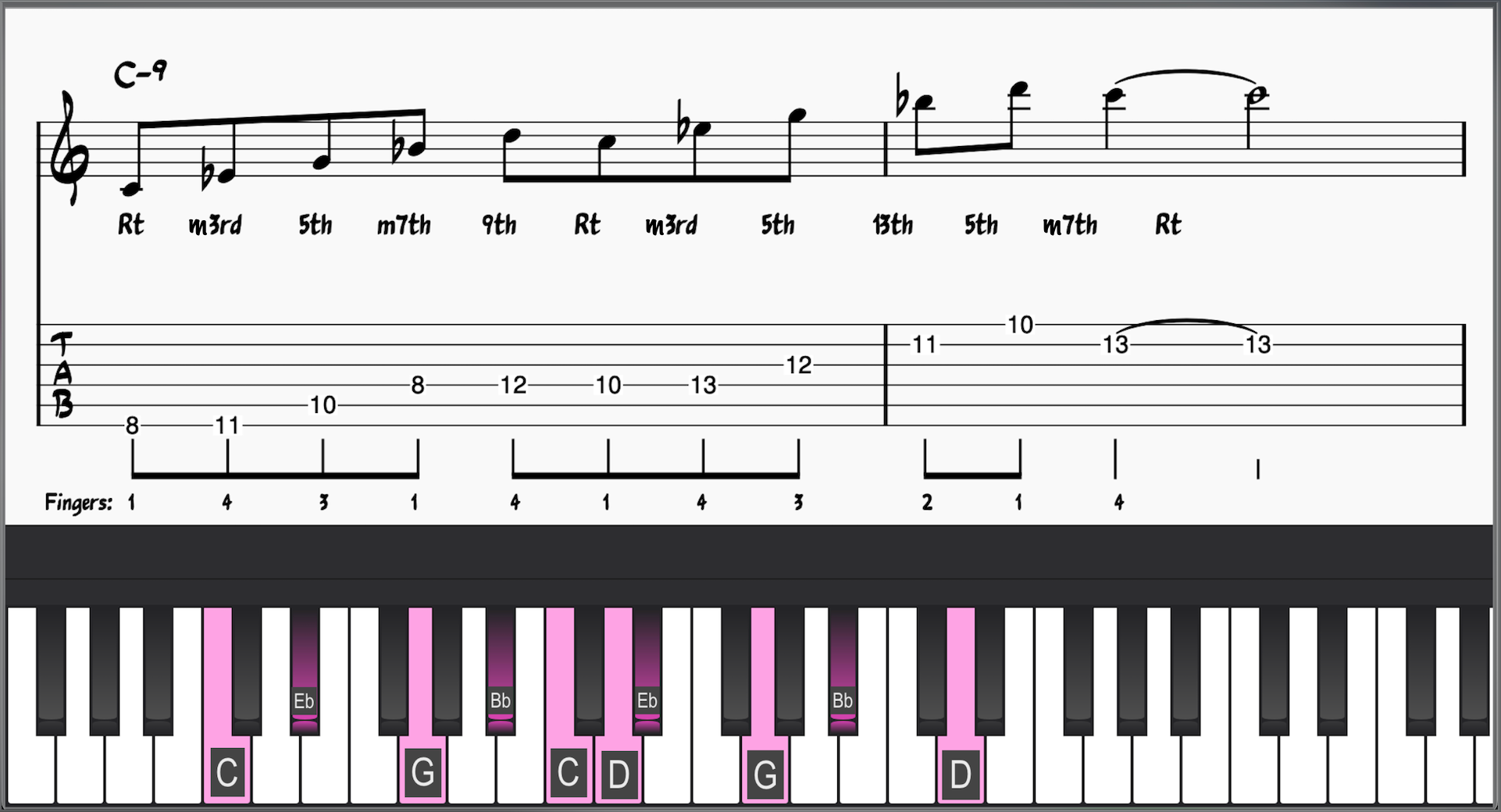
- 9th: D
- m7th: Bb
- 5th: G
- m3rd: Eb
- Rt: C
20. Minor 11 Arpeggios
Minor 11th arpeggios take a minor seventh chord and add a compound 11th interval on top: [C, Eb, G, and Bb] plus [F]. Minor 11th arpeggios can also include a natural 9th.
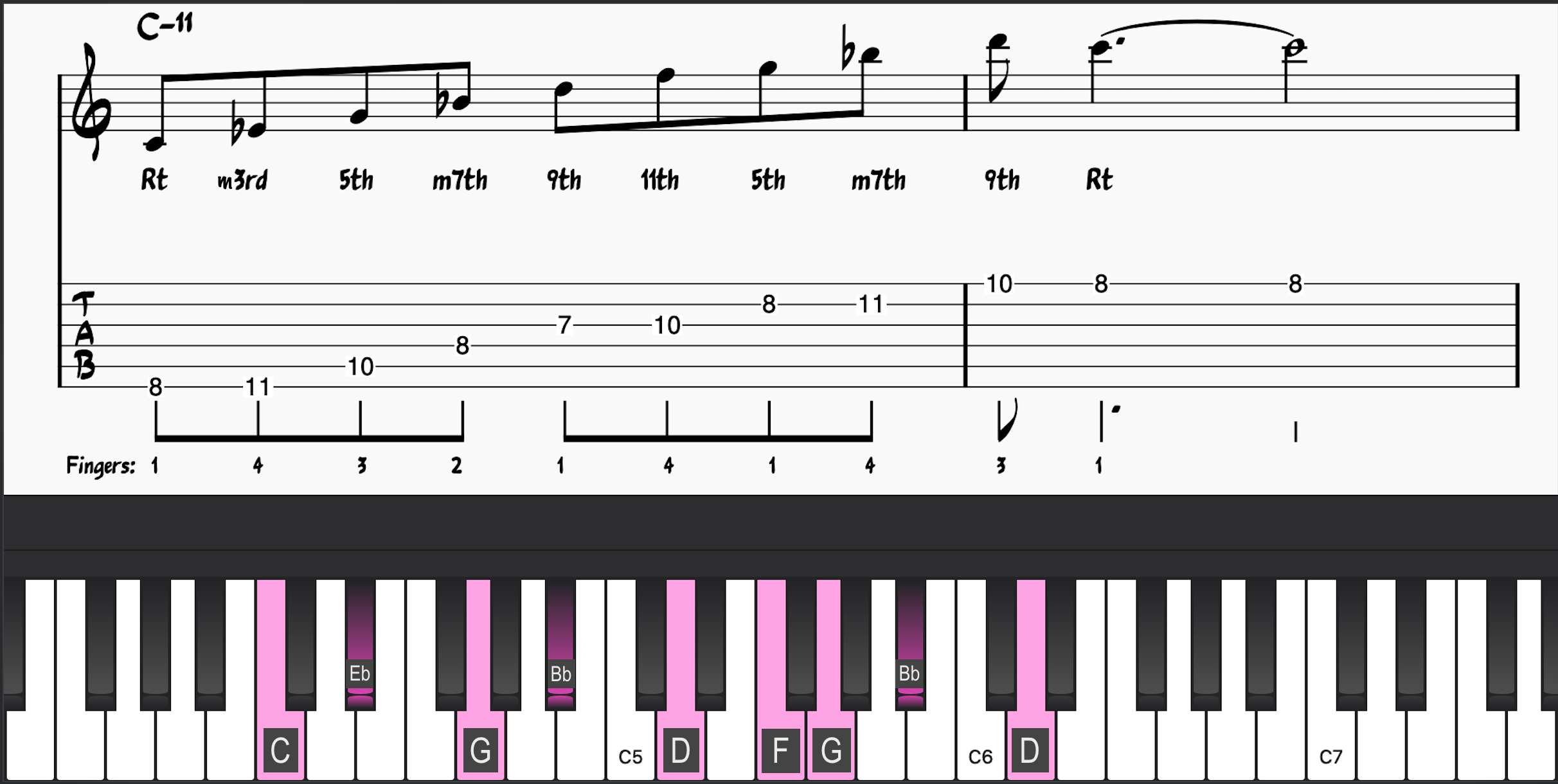
- 11th: F
- (9th: D)
- m7th: Bb
- 5th: G
- m3rd: Eb
- Rt: C
21. Quartal Arpeggios
I wanted to include a more harmonically ambiguous arpeggio for our last arpeggio.
Quartal harmony is often used in jazz to create tonal ambiguity and give the improviser more harmonic freedom. Piano players like McCoy Tyner popularized quartal harmony as a way of playing over chord changes.
Try this particular arpeggio over static chords or modal tunes to hear how the stacking fourths interact with a particular chord or tonal center.
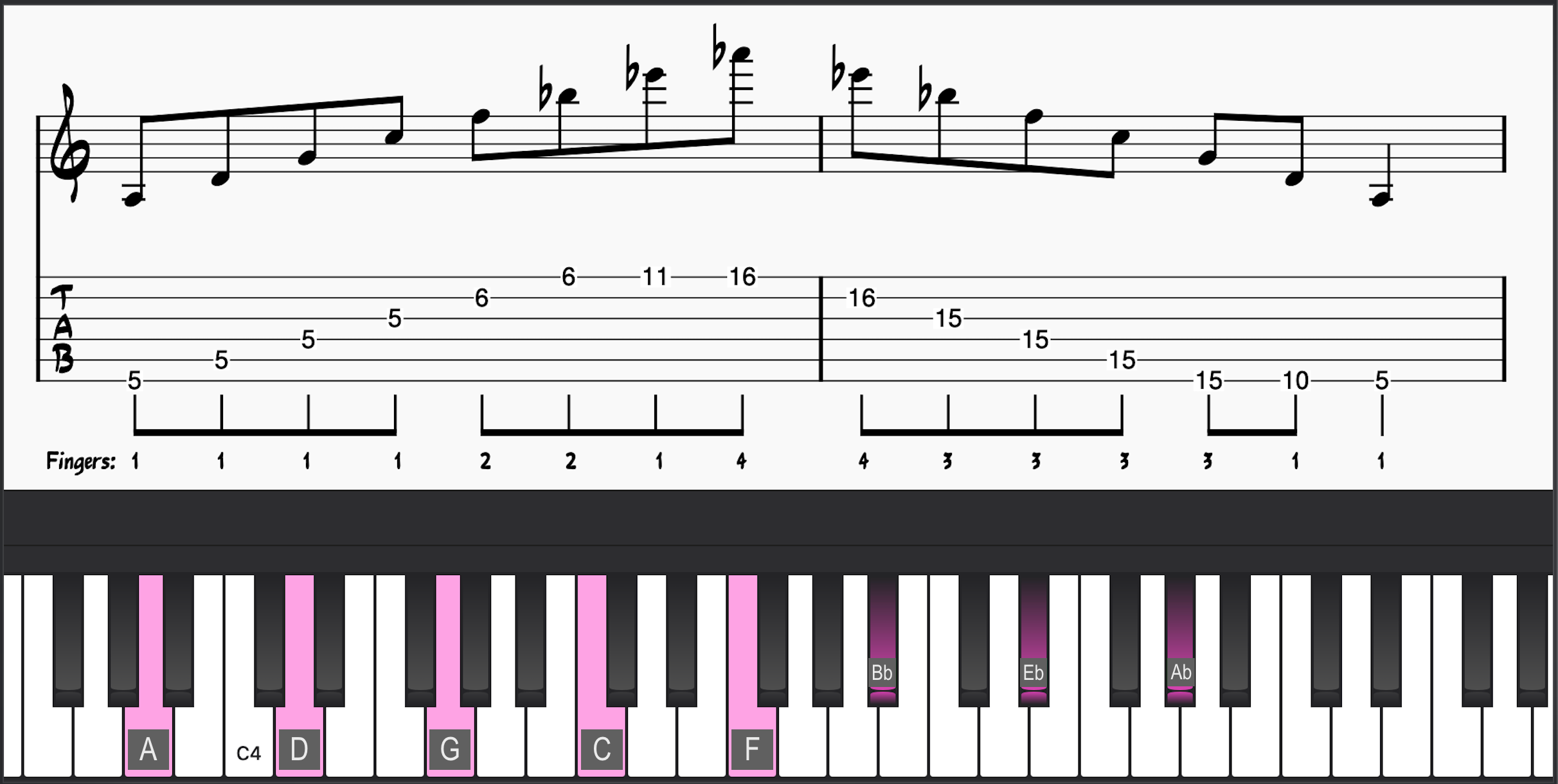
How To Practice Arpeggios On Guitar, Piano, or Any Instrument
Let’s take what we’ve learned and talk about the best way to practice memorizing and applying arpeggios in musical situations.
Arpeggio Patterns
The examples we’ve looked at so far share a few characteristics:
- They all started on the root of the chord
- They all ascended with few or no pivots
- They were all 8th-note based in their rhythms
However, when practicing arpeggios on your own, you’ll want to introduce variables to change things up and try different arpeggiation patterns.
Some ideas:
- Start on the 3rd, the 5th, the 7th, or an extension
- Begin on the highest note and play in descending order
- Play arpeggios non-linearly; for example, play rt, 5th, 3rd, 7th, 9th
- Introduce chromatic approach tones
- Introduce different rhythms into your arpeggio exercises
Arpeggiating Chord-Scales
You can practice many different exercises and variations when working on different arpeggios. Here are two examples of arpeggio exercises over a C major chord-scale:
Arpeggio Exercise 1: Ascending chord scale made of triads played in ascending order

Arpeggio Exercise 2: Ascending chord scale made of triads played in descending order
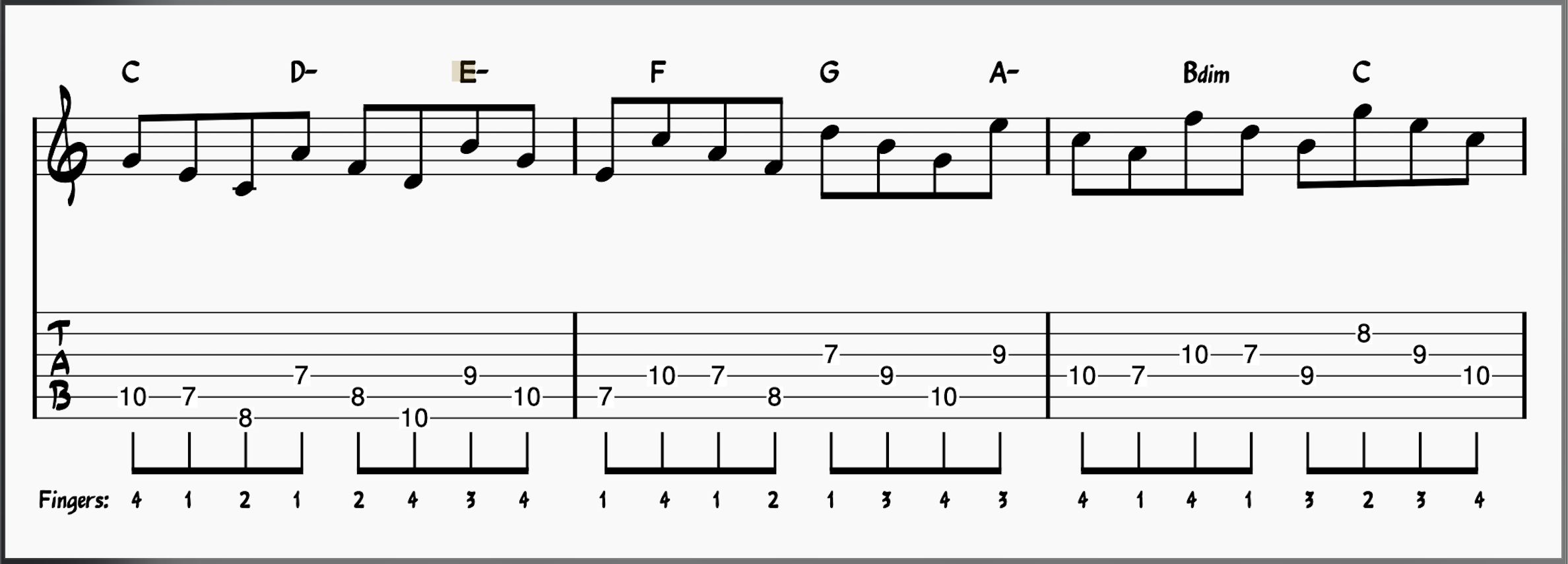
Arpeggiating Through Changes
Also, you’ll want to take these arpeggios and try moving them through chord progressions to help hear the changes as individual notes. There isn’t a hard or fast rule for this as long as you are (mostly) hitting the notes in the specified chord.
Here are sample arpeggiated chords for the first eight measures of the jazz standard All the Things You Are. The pivot points were designed to help you reach the beginning of each measure on the chord’s root, except for the last change, which starts on the 3rd of the chord (Cmaj7).
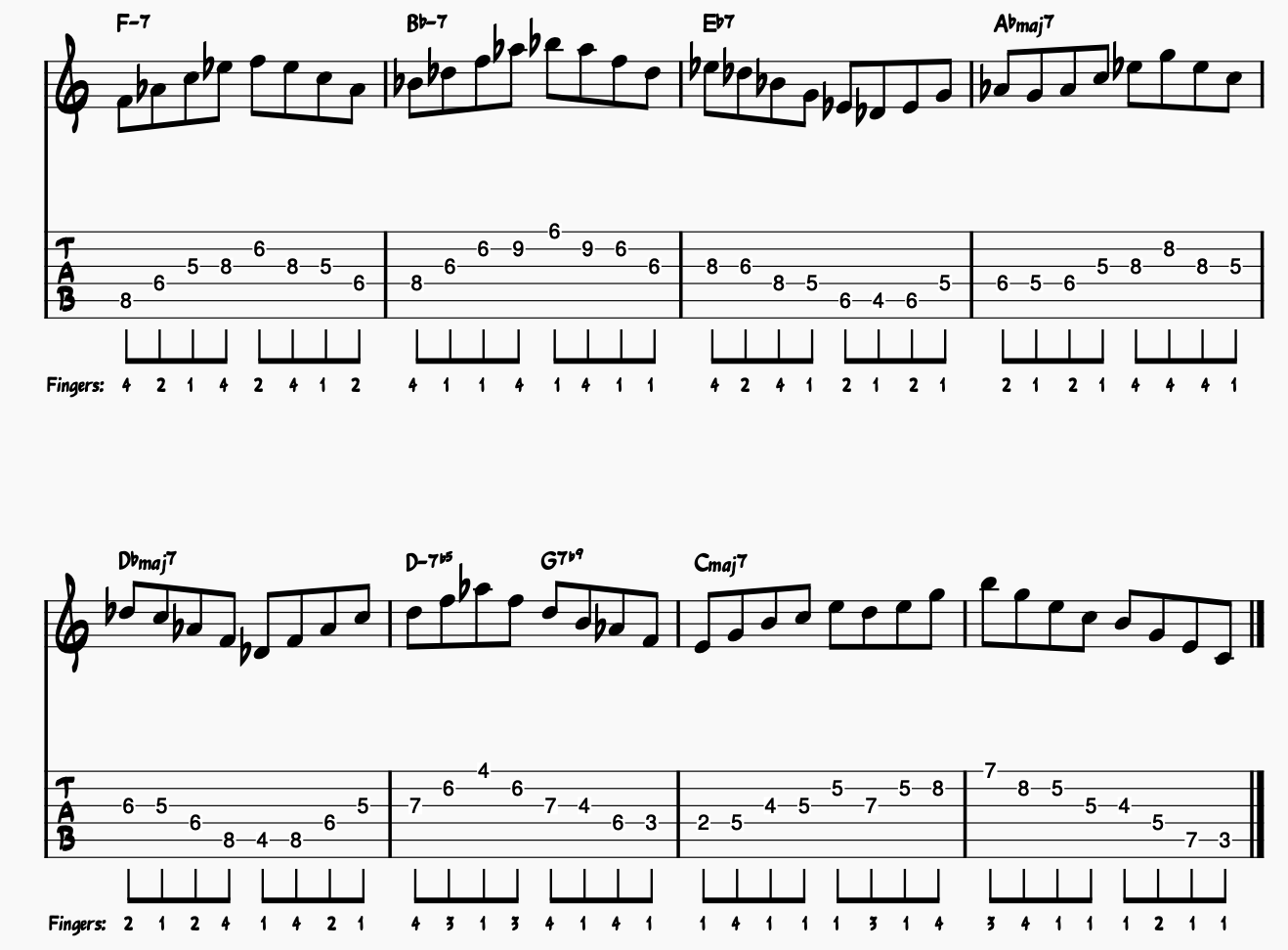
You’ll definitely want to write out your own etudes to practice over jazz standards you know or are actively learning. This is a great way to practice improvisation and memorize the changes simultaneously!
Want To Make The Most of Arpeggios? Join The Inner Circle and Improve Your Playing in 30 Days or Less.
If you want to learn to play arpeggios like a pro, check out the Learn Jazz Standards Inner Circle.
We’ve got an abundance of instrument-specific and instrument-agnostic resources designed to help you take your playing to the next level and break through any annoying practice plateaus keeping you from reaching your musical goals.
Practice smarter, not harder. Join the Inner Circle.






